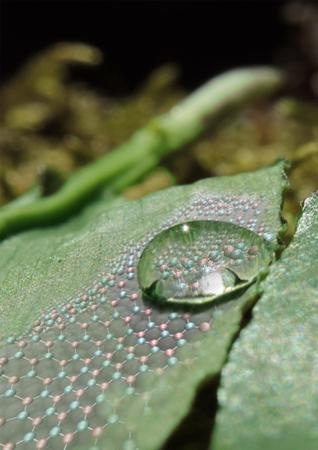Jun 30 2016
The lotus leaf has a unique feature that prevents the leaf from getting wet when rain falls on it. The water just rolls off without actually wetting the surface of the leaf. This novel characteristic has made room for the possibility of developing artificial materials that are water-repellent just like the lotus leaf. However, this task of developing a switchable wetting surface is indeed challenging. A team of researchers from TU Wien, KU Leuven and University of Zürich have succeeded in allowing a surface of a single layer of boron nitride to switch back and forth between states with low and high adhesion and wetting.
 The atomic structure determines the wetting and adhesion properties.(Credit: (Gábor Mészáros & Ruth Lanza))
The atomic structure determines the wetting and adhesion properties.(Credit: (Gábor Mészáros & Ruth Lanza))
Hexagons making waves
“One of the most interesting physical properties of a surface is its stiction or static friction" says Stijn Mertens (Institute of Applied Physics at the Vienna University of Technology, and associated with KU Leuven in Belgium). “This force has to be overcome for an object on the surface to start sliding." The stiction of the surface is determined to a great extent by its nanostructure. Information about the contact between the surface and an object like a liquid drop for instance rely on the geometry of its atoms and also on various other characteristics. This is significant for wetting, stiction and adhesion. There currently exits a very poor understanding of the association between stiction and wetting.
"Just as the material graphene consists of only one layer of carbon atoms, our boron nitride -- which contains as many boron as nitrogen atoms -- has a thickness of only one atomic layer", explains Thomas Greber from the Physics Institute at the University of Zürich. It is possible to grow this extremely thin layer on a rhodium single crystal. A hexagonal pattern is formed by the atoms in the boron nitride and the rhodium surface. However, the distances between the atoms present in the two materials are different. Thirteen atoms present in boron nitride use the same space like that used by twelve rhodium atoms, in order to prevent the two crystals from perfectly fitting together. This difference leads to the bending of the boron nitride hexagons that emerge as a frozen wave with a height of about 0.1 nanometres and a wavelength of 3.2 nanometres.
Precisely this two-dimensional nanowave influences the wetting of the surface by water.
Stijn Mertens.
Despite the situation, it is possible to flatten the boron nitride superstructure by just inserting the material in acid and then introducing an electrical voltage. This results in hydrogen atoms slowly moving under the layer of the boron nitride. The adhesion of a water drop unexpectedly changes even though the drop appears to be 100'000 times larger than the extremely small waves existing in the boron nitride. This effect gets reversed when there is a fall in the voltage.
We can switch the surface again and again between these two states.
Stijn Mertens.
The drop-measuring machine
An instrument was specifically constructed to help analyze the wetting of the surface and then simultaneously apply the voltage. This investigation was carried out by allowing a drop of liquid to contact the surface through a glass tube that is extremely thin. The size of the drop is both increased and decreased and its shape is also recorded at the same time. The properties of the surface determine whether the shape of the drop is extremely rounded or flat.
The idea of switching back and forth the wetting of a surface has been in existence for some time. For instance, organic molecules that alter their shape with a specific color light can be fixed to the surface. These molecules seem to be a lot more delicate and complicated when compared to the materials analyzed in this research.
Our surface consists of only a single layer of atoms, is completely inorganic and does not change even if we heat it in vacuum to 1000 °C. This means that this material could also be used for applications where organic molecules would long be destroyed, ranging from daily life to space travel.
Stijn Mertens and Thomas Greber